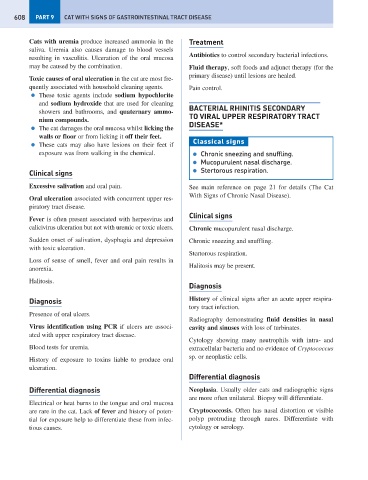Page 616 - Problem-Based Feline Medicine
P. 616
608 PART 9 CAT WITH SIGNS OF GASTROINTESTINAL TRACT DISEASE
Cats with uremia produce increased ammonia in the Treatment
saliva. Uremia also causes damage to blood vessels
Antibiotics to control secondary bacterial infections.
resulting in vasculitis. Ulceration of the oral mucosa
may be caused by the combination. Fluid therapy, soft foods and adjunct therapy (for the
primary disease) until lesions are healed.
Toxic causes of oral ulceration in the cat are most fre-
quently associated with household cleaning agents. Pain control.
● These toxic agents include sodium hypochlorite
and sodium hydroxide that are used for cleaning
BACTERIAL RHINITIS SECONDARY
showers and bathrooms, and quaternary ammo-
TO VIRAL UPPER RESPIRATORY TRACT
nium compounds.
DISEASE*
● The cat damages the oral mucosa whilst licking the
walls or floor or from licking it off their feet.
Classical signs
● These cats may also have lesions on their feet if
exposure was from walking in the chemical. ● Chronic sneezing and snuffling.
● Mucopurulent nasal discharge.
Clinical signs ● Stertorous respiration.
Excessive salivation and oral pain. See main reference on page 21 for details (The Cat
With Signs of Chronic Nasal Disease).
Oral ulceration associated with concurrent upper res-
piratory tract disease.
Clinical signs
Fever is often present associated with herpesvirus and
calicivirus ulceration but not with uremic or toxic ulcers. Chronic mucopurulent nasal discharge.
Sudden onset of salivation, dysphagia and depression Chronic sneezing and snuffling.
with toxic ulceration.
Stertorous respiration.
Loss of sense of smell, fever and oral pain results in
Halitosis may be present.
anorexia.
Halitosis.
Diagnosis
Diagnosis History of clinical signs after an acute upper respira-
tory tract infection.
Presence of oral ulcers.
Radiography demonstrating fluid densities in nasal
Virus identification using PCR if ulcers are associ- cavity and sinuses with loss of turbinates.
ated with upper respiratory tract disease.
Cytology showing many neutrophils with intra- and
Blood tests for uremia. extracellular bacteria and no evidence of Cryptococcus
sp. or neoplastic cells.
History of exposure to toxins liable to produce oral
ulceration.
Differential diagnosis
Differential diagnosis Neoplasia. Usually older cats and radiographic signs
are more often unilateral. Biopsy will differentiate.
Electrical or heat burns to the tongue and oral mucosa
are rare in the cat. Lack of fever and history of poten- Cryptococcosis. Often has nasal distortion or visible
tial for exposure help to differentiate these from infec- polyp protruding through nares. Differentiate with
tious causes. cytology or serology.

